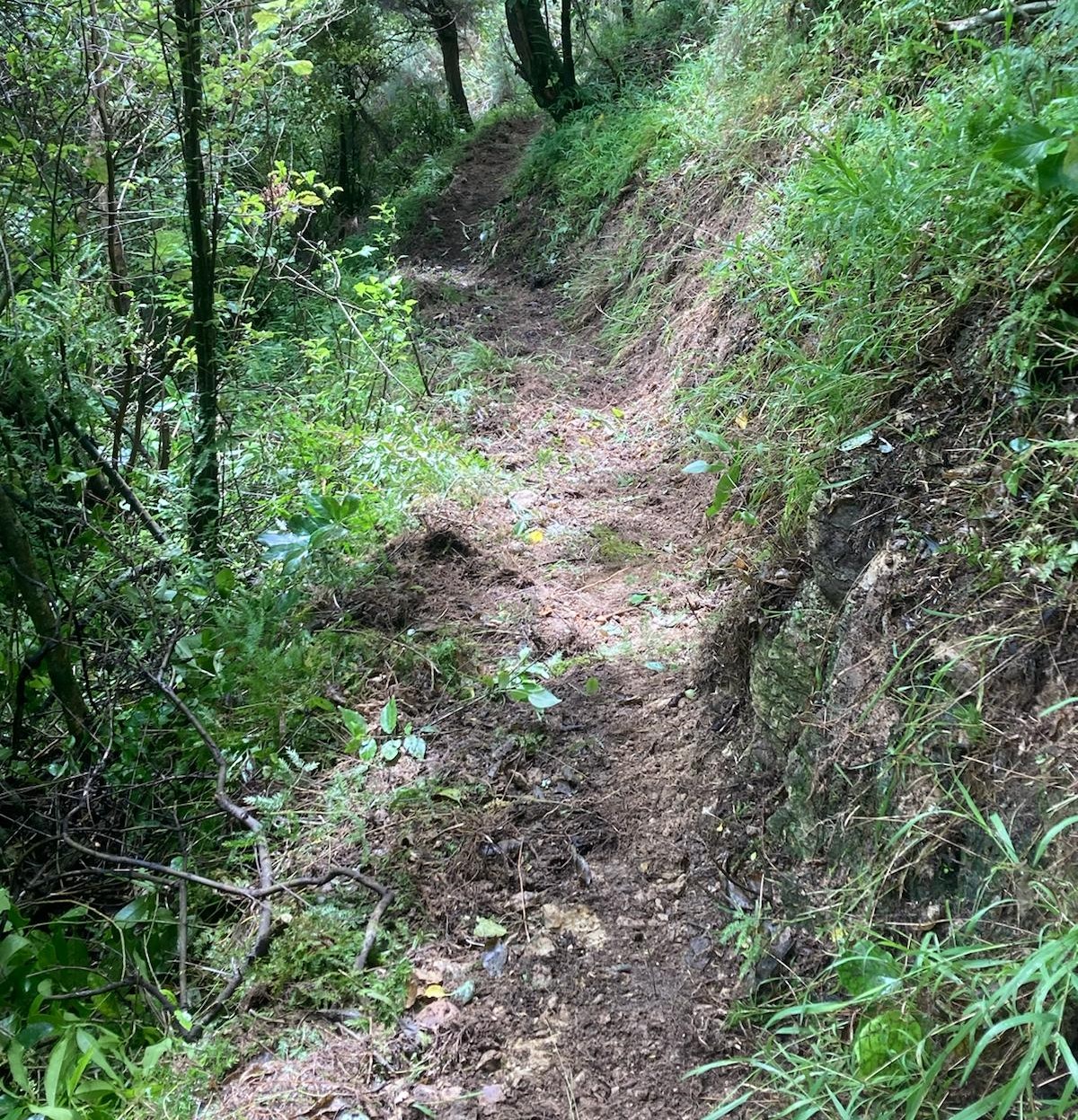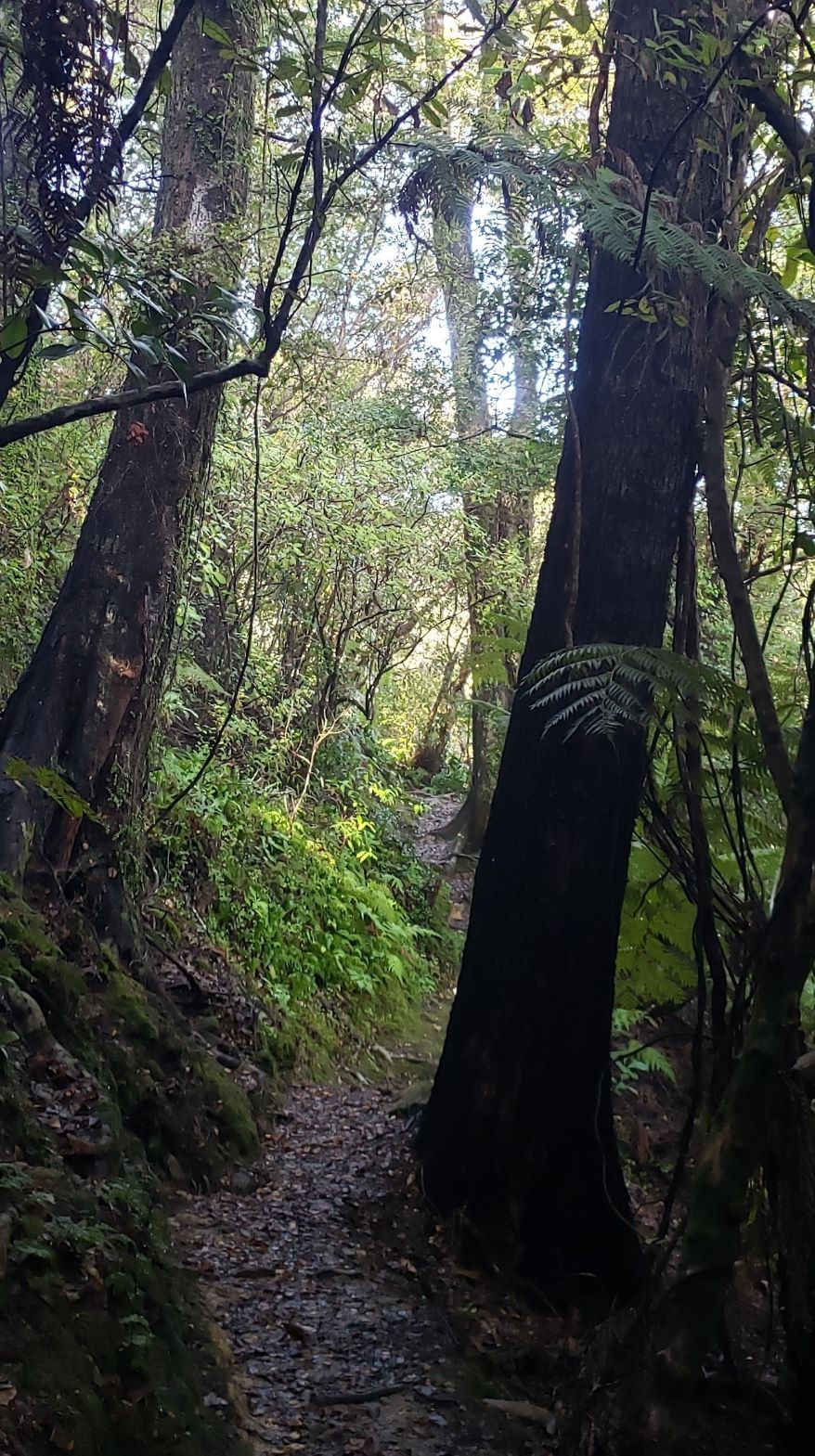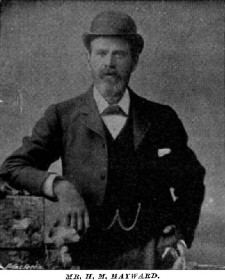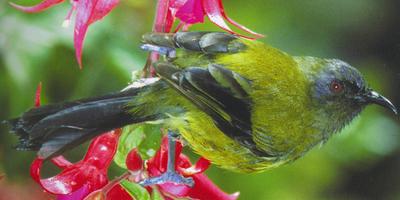Next Working Bee

Date & Time
10:30am to 12:30pm
8 & 15 February 2025
Where
Meet at the end of Mawson Street at 10:30am. We will work on the Mawson Ridge and Tyndall Ridge Tracks.
What We'll Do
We'll be maintaining existing tracks, re-benching and pruning overgrowth.
What To Bring
If you don't have any tools you're still very welcome, we'll bring some spares.
The most useful tools are gloves, a pick (aka mattock or grubber) and hedge clippers or lopers.
You might also like to bring along a spade, rake or hand saw.
Also don't forget to bring some water and sun/rain protection.
ABOUT US
Friends of Hayward's Scenic Reserve
The "Friends of Hayward's Scenic Reserve" is a group of local volunteers who maintain the historic trails in the reserve, originally founded by Russ McStay.
The group has ebbed and flowed over the years, depending on the availability of volunteers. As at early 2025 it is currently a small group in the process of rebuilding.
To join the Friends' Mailing List contact either of the co-ordinators, Bill Trompetter or Martin Ryan. Bill can be contacted on 022 363 2055 or b.trompetter@gns.cri.nz. Martin is 022 6539 527 or martin.w.ryan@gmail.com
You can find out about other groups that volunteer in Lower Hutt here.

HELP US
Ways you can help
If you'd like to help the Friends of the Reserve there are a few ways you can.
Adopt a track
Look after a specific track by regularly walking it and keeping it maintained. The list of tracks below notes which tracks are open for adoption.
Working bees
Join us once in a while for a working bee. No commitment, just show up with or without tools and pitch in for a few hours.
Keep a look out
Let us know if any of the tracks need some attention.
Behind the Scenes
Make signs, help us co-ordinate with the council, manage volunteers, create and run the socials.
History of the Hayward Scenic Reserve
The Reserve was originally private property owned by the late Harry Miles Hayward (1857-1953). Hayward is now recognised as one of the Hutt Valley's very early conservationists. He noted that the then widely followed practice of clear-felling and burning of the native bush cover on the valley's eastern hills led to erosion and topsoil fertility failure after. He decided not to adopt this practice on all of his land.
He was apparently unpopular in some quarters after publicly warning that pastoral farming of these unstable slopes, using the slash and burn technique, was unsustainable and would give rise to serious erosion problems.
Over the years an extensive network of interconnecting tracks was cut by Mr Hayward's farm hands, from his homestead at the top of Tyndall Street, to give access to the more scenic parts of his property and lookout points.
The original track formed by Hayward farm labour ran from the homestead on to the ridge immediately to the north of it, where a flagpole once stood. From there, the track divided, penetrating into the Reserve at three different levels. A track was then cut to the south, giving access to the bottom of the Wainuiomata Hill Road. Later, from the track alongside the Whites Line stream, further tracks were cut northwards to a prominence called Cabbage Tree Knoll on what is now the Te Whiti fire break ridge, and upwards through a bush gully to a point named 100 Mile View. The Knoll provided a rewarding view of the Hutt Valley and Wellington Harbour. The magnificent outlook from 100 Mile View extended to Mt Tapuaenuku in the Inland Kaikoura Range, the nation's next highest mountain (2885m) after Mt Aspiring and the main peaks in the Mt Cook area. The remains of most of what was the lowest level track have long been incorporated into subdivided residential lots. The original mid-level track, now known as the Hayward Track, provides a pleasant bush walk link between Whites Line East and Mawson Street. Most of the other historic tracks on public land can still be followed.
The bush covered hillside part of the Hayward property was gifted to the Crown in 1938 and shortly afterwards was gazetted as a Scenic Reserve, administered by the Lands & Survey Department until 1957. In 1952 the Lower Hutt City Council was approached about taking over control and maintenance. The land was finally vested in the Council in June 1958.
In 1946 Mr O. Dryden was appointed Honorary Inspector, a position renamed Honorary Ranger in 1955 under the Reserves and Domains Act of 1953. Mr Dryden was actively involved with the protection and maintenance of the Reserve over a period of many years. In 1970 he compiled a brief history of the Reserve, and it is from his notes that most of this historical information has been derived. The former All Black winger, Mr Ron Jarden was also an appointed Honorary Ranger from 1970 until his death.
Read more about Harry Miles Hayward in this report created by Heritage Research Associates for the Hutt City Council in 2010.

Harry Miles Hayward. Image from National Library
This history is the result of research conducted by John McKenzie, including identifying the original track names used by HM Hayward.
Wildlife
Bellbirds in the Reserve
Sightings of lone birds have been reported ranging between Cleary St in the north to Mawson St in the south. I fear they are lonely males, and that future breeding in our reserve may depend upon pairs choosing to migrate here from areas (e.g. MIRO's intensive pest controlled area in EHRP) where females have not been wiped out by predation. How satisfying it would be if somebody actually sights a female in our reserve!!
According to the Readers Digest "Complete Book of New Zealand Birds", bellbirds are strictly monogamous and pairs remain together for several years. They court in winter when the male sings in front of the female. During this display the male holds its body almost vertical and hovers or flies slowly upwards making a loud whirring noise with its wings. After mating the pair stay constantly together and often duet.
Each pair remains in its range, but there is often considerable overlap of adjacent ranges. Birds sing and countersing to space themselves in relation to each other. They move outside their ranges to feed at concentrated nectar sources. At such food areas bellbirds interact vigorously with much displaying, chasing and singing.
They eat nectar from many native and introduced plants. They take soft berries during the late summer and autumn, when nectar bearing flowers are less common. They catch small invertibrates, especially insects and spiders, in considerable quantities, most commonly by gleaning trunks, branches and leaves, but also by hawking. Females take more insects and less nectar than males. Except at concentrated nectar sources, feeding bellbirds are usually silent.
Brief recognition guide: Size - 200mm (8 inches) Vigorous movements, slender proportions, with a distinctly arched bill and shallow fork in tail. Located by characteristic bell-like song. Flight often noisy.

A male bellbird

A female bellbird
Biodiversity
Biodiversity in the Reserve
The original vegetation of the Eastern Hills was predominantly hard beech and black beech, with larger forest trees such as rimu, kahikitea and miro showing through the canopy in gullies and wetter areas. With the first European settlement of the Hutt Valley in the 1840's came extensive burning of the local native forest and most of the present forest dates from the times of these early fires. Today the Reserve has rimu, miro, pukatea, beech, tawa, northern rata, kawakawa, mahoe, mamaku, kanuka, manuka and many more shrubs and ferns. Following the fires of early settlers, gorse took hold and some parts of the Reserve became heavily covered with gorse and scrub. Over the years, there were a number of large scrub fires in areas adjoining the Reserve, but luckily none of these fires entered the Reserve.
In 1955 the Lower Hutt City Parks Department provided 2,000 trees which were planted by volunteers in an area adjacent to the northwest boundary. These trees acted to suppress the growth of gorse, and so reduce the risk of fire entering the remnant native bush in the Reserve. On several occasions since then the Reserve has had further activity including a number of planting ceremonies on Arbour Day. A kauri tree was planted on one of these Arbour days by the late Sir Walter Nash. It is now on private property but can be seen up the drive to the left just before the entrance on Whites Line East.
The Reserve's forest and scrub communities provide refuge for a number of native bird species. These include the tui, bellbird, fantail, waxeye, grey warbler, native pigeon, and morepork.
Despite its fire risk, gorse is beneficial by fixing nitrogen in the topsoil and providing an excellent nursery cover under which young native tree species become established and thrive. Over time the native species emerge from and eventually smother the gorse canopy, causing its complete collapse.
Unfortunately, a number of unwanted exotic plant species, some in the noxious weed category, are also present in parts of the Reserve and adjoining slopes. Nasties include Banana passionfruit (Passiflora mollissima), Old man's beard (Clematis vitalba), Climbing asparagus or Snakefeather as it is now commonly called (Asparagus scandens), Japanese honeysuckle (Lonicera japonica), and Wandering Jew (Trandescantia fluminensis). Other unwanted exotics include Blackberry (Rubus fruticosis agg.), Himalayan honeysuckle (Leycesteria formosa), Hawthorn (Crateagus monogyna), several wattle (Acacia) species, and some wilding pine species.
Visitors to the Reserve are encouraged to pull out the seedlings of any unwanted exotics which they may encounter and to immediately notify the Hutt City Council concerning the whereabouts of any infestations of Banana passionfruit or Old man's beard which they have seen.
Information on any intensification of the weed control policies of the Hutt City Council or Greater Wellington - the Regional Council, as they relate to species known to be in the Reserve, will be posted on this website from time to time.
Haywards Scenic Reserve is a Key Native EcoSystem. View the plan here (PDF).
Newsletters
Newsletters
Click the links below to read recent and not so recent newsletters. Newest at the top.
